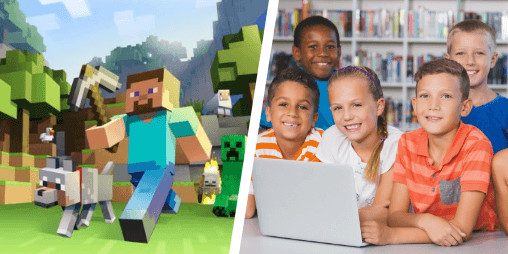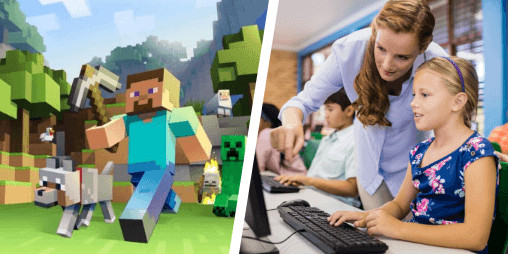Our offer of programming courses includes tens of items, so we recommend using filters to narrow down the choice. Firstly, select the location which is most conveniently reached with the child or from which we can pick the child. In the second step, select the language of instruction in which the child will learn (we offer courses in English and Polish). Next, notice the age group and choose the appropriate one for the child. After filtering the courses, there will be one or several courses left. Now you can read the course descriptions and select the course which best suits the child’s interests.
The first class of each coding course can be always a trial class. You can enrol the child in it with no commitments, just select the right option on the enrolment form. After the first class, we will ask you to confirm whether the child will participate in the course and if so, to pay the course fee.
Age groups specified for the programming courses for children and teens are our recommendation, not strict guidelines. However, they are worth taking into account. Our experience tells us that children below the recommended age group will do well during the course if they meet one or more of the following conditions:
- feel well handling the computer,
- have completed other programming-related courses or programming exercises at home,
- have experience in cooperation with older children, e.g. attend other courses with older children or spend a lot of time with older siblings at home.
The most important thing is to encourage the child to learn programming and not discourage from it. Only some children will find working with older students to be a motivation for learning. For most it would be a difficult and discouraging experience.
Considering enrolling a child in a course designed for older children, it is worth to think about the natural milestones in the child’s development – to which our courses are adjusted. The first important milestone is learning how to read. Children who don’t know yet how to read, learn at our school only in the youngest age group for grades 0–2. The second milestone is the transition from block-based to text-based coding. In our programming courses for children we gradually introduce elements of text-based coding, beginning from the second grade. However, only courses for the sixth and higher grades are solely based on text-based coding. We know from experience that only a handful of young programmers from the fifth grade are able to successfully complete these courses. The majority of the children needs to “grow into” the purely text-based coding which requires a lot of patience. We do not recommend skipping this phase too quickly, ahead of the child’s natural abilities.
If, having considered all these factors, you still have doubts about the right group, let the child try our classes. Already after the first class in both age groups it will be possible to draw conclusions and discuss the child’s abilities with the instructors. Then you can choose the group that is best suited to your child’s needs.
Our age groups encompass three-year-long periods (grades 0–2, grades 2–4, grades 4–6, grades 6–9). Some siblings, e.g. children from the second and the fourth grade, will naturally be in the same group. Sometimes, however, due to different ages, abilities and interests, children will be placed in different course groups. Older children need fresh challenges, younger children need more support. We know how important for the parents is the logistics, and that the possibility to bring siblings to the classes together will be easier on the family schedule. In such cases we try to meet the parent’s expectations. We enrol the siblings into one group and the instructor, during the classes, tries to guide the younger child through the exercises individually, selecting easier tasks. This solution will not always be possible, but it is worth to ask about it during enrolment.
Please contact us directly by e-mail or phone. It might be possible to launch an additional course in a new location. Minimum 5 children are required to start a new group.
We add new course groups adjusting time slots to the schedules of the children. Please contact us about specific course times. We especially welcome inquiries concerning children from the Primary School No. 358 who attend school in shifts – in the mornings and afternoons – as we offer morning classes which are a quality option for children in the time which usually would be spent in a crowded clubroom at school.
If our offer of programming courses for children and teens is not available at your child’s school, please contact us. We will gladly create new course groups at a new school.
If our classes take place at the Kids Coder Lab’s host school, children are picked up from the school clubroom in close cooperation with the management and clubroom of the school and the procedure does not require any action from the parents. We follow the guideline of the given school.
If the classes take place at our headquarters, at ul. Hlonda 10, and the child is to be picked up at one of the schools at ul. Hlonda or ul. Ledóchowskiej, we ask you to contact us. We will send you an authorisation form which will include contact details of our staff. The form should be printed, signed and left at the clubroom or secretary’s office of the school (according to the school’s guidelines). We will be able to pick up the child based on this authorisation.
For children picked up from the Primary School No. 358, the important element of the pick-up procedure is the lunch schedule. This schedule is available on the school’s website and we monitor it closely. Please take it into account when enrolling your child, so that our courses do not clash with the child’s lunch break. It’s no fun to code on an empty stomach!
Please provide us with all additional information about the child’s pick-up, e.g. at which room will the child be waiting, and any changes, e.g. a change in a pick-up place from the child’s classroom to a different room.
Please also tell the child that a member of the Kids Coder Lab staff will pick the child up. Children like to know what to expect. It is important for the child to be instructed to follow the Kids Coder Lab employee’s rules while going from the school to Kids Coder Lab, e.g. walk in pairs, keep close to the group etc. The attitude of the child is extremely important for the child’s and the group’s safety. Discussing it at home is key.
Our offer
 Comming soon
Comming soon

Programming with Minecraft 2 (Master)
Grades 4–6 Onsite 1 year long Polish
 Enrol now
Enrol now

Intermediate Python
Grades 4–6 Onsite 1 year long English
 Enrol now
Enrol now

Programming with Minecraft (mods)
Grades 2–4 Onsite 1 year long English
